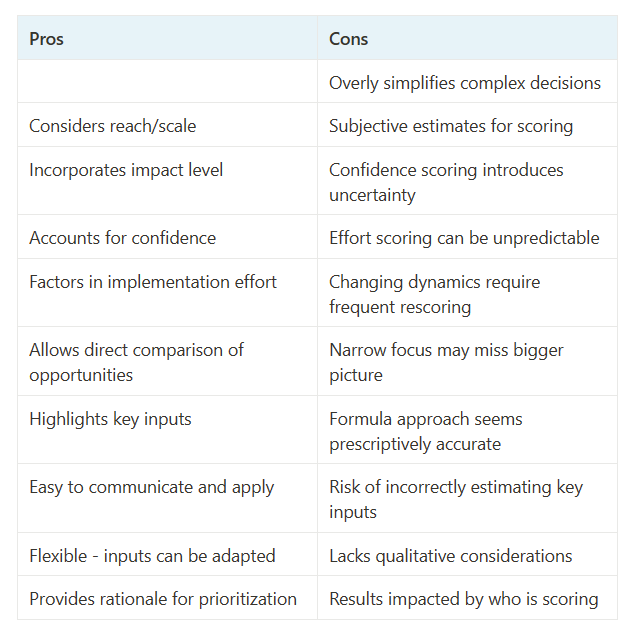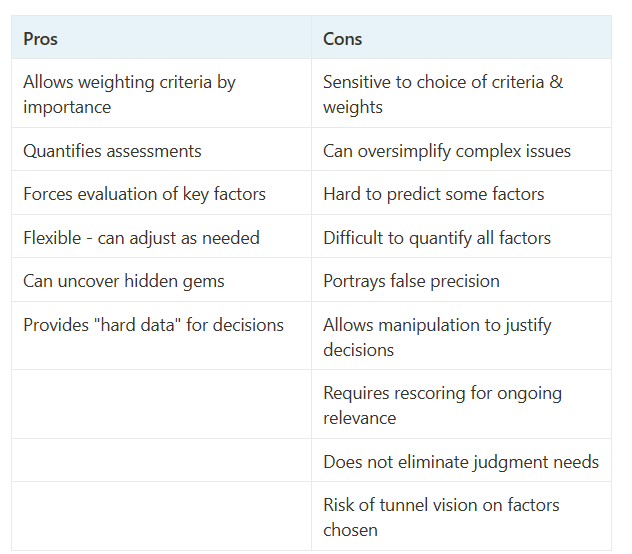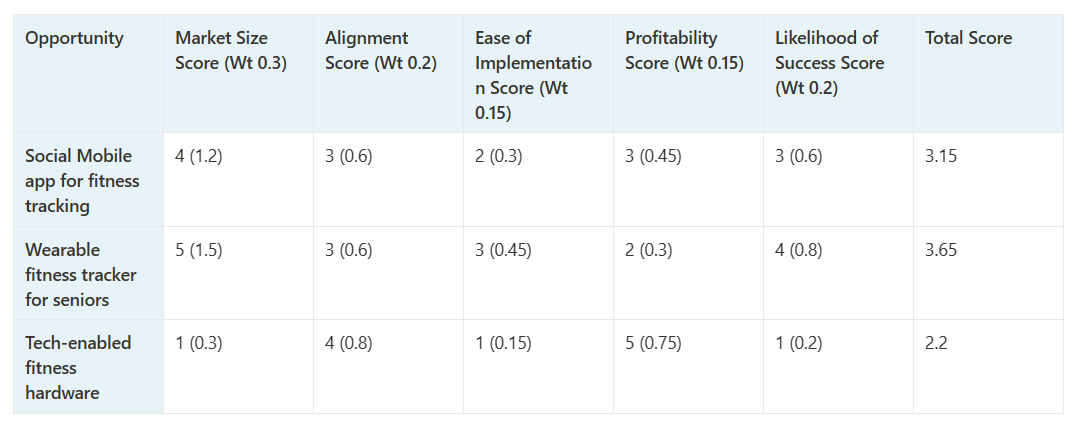Use Cases for Selected Product Management Prioritization Frameworks
A product manager asked me recently which frameworks would be the most useful given certain contexts. This is an attempt to help answer that question.
As a product manager, you’re constantly faced with the challenge of deciding what to work on next. You have a backlog of ideas, features, and requests from various sources, but you can’t do them all at once. How do you choose the most valuable and impactful ones for your product and your customers?
This is where prioritization frameworks come in handy. A prioritization framework is a tool that helps you evaluate and rank your product opportunities based on different criteria, such as customer value, business goals, effort, and risk. By using a prioritization framework, you can, in theory, make more objective and data-driven decisions, align your team and stakeholders, and avoid wasting time and resources on low-priority items.
There are many prioritization frameworks out there, each with its advantages and disadvantages. In this post, I’ll discuss with you to five of the more widely used ones, and show you some use cases for each of them. These are:
RICE: Reach, Impact, Confidence, and Effort
KANO: Customer Satisfaction vs. Investment
Opportunity Scoring: User Value vs. Relative Preference
Cost of Delay: Urgency vs. Value
Buy a Feature: Customer Willingness to Pay
Let’s dive in and see how these frameworks can help you prioritize your product work.
RICE: Reach, Impact, Confidence, and Effort
RICE is a simple and intuitive framework that scores each product opportunity based on four factors:
Reach: How many people or events will be affected by this opportunity over a given time period?
Impact: How much will this opportunity improve the key metric or goal that you’re trying to achieve?
Confidence: How confident are you in your estimates of reach and impact?
Effort: How much time and resources will it take to implement this opportunity?
To calculate the RICE score, you simply multiply the reach, impact, and confidence scores, and divide them by the effort score. The higher the RICE score, the higher the priority.
The RICE prioritization framework is typically preferred over other models in certain situations:
Simplicity is valued over comprehensive analysis. RICE uses only 4 scoring factors - Reach, Impact, Confidence, and Effort. This makes it very easy to apply even without extensive training or resources. The simplicity of RICE is an advantage when depth of analysis is not required.
Speed is important. RICE allows opportunities to be quickly prioritized by intuitively judging the relative Reach, Impact, Confidence and Effort. Its straightforward criteria facilitate rapid scoring to gain a fast sense of priorities.
Subjective human judgment is trusted. RICE relies heavily on individual scoring and gut feelings rather than extensive objective data. The model assumes human intuition on its criteria will lead to good prioritization.
Direction rather than precision is needed. Due to its simplicity, RICE provides more general guidance and rough comparisons rather than finely calibrated ratings. It gives the direction of priorities rather than numerical precision.
Resources are highly constrained. RICE requires minimal time, expertise and effort compared to more involved frameworks. When resources are stretched thin, RICE offers a lightweight model.
Stakeholder alignment is key. RICE's transparent criteria make it easy to explain priorities to stakeholders and leadership. The simple factors help justify priorities to others.
Flexibility is desired. The RICE criteria can be adapted on the fly as organizational needs and objectives shift. It allows pivoting priorities as circumstances change.
RICE may be preferred when simplicity, speed, intuitive judgment, resource constraints, flexibility, and stakeholder coordination outweigh the need for rigorous analysis and detailed precision in prioritization processes.
Pros and cons
Here’s an example of how to use RICE to prioritize three features for an e-commerce product:
Based on the RICE scores, the checkout optimization feature has the highest priority, followed by the loyalty program and the referral program.
KANO: Customer Satisfaction vs. Investment
KANO is a framework that categorizes product features based on how they affect customer satisfaction and how much investment they require. It assumes that different features have different levels of importance and expectations for customers and that not all features are equally satisfying or dissatisfying.
According to the KANO model, there are five types of features:
Basic: These are the features that customers expect to have in the product, and that cause dissatisfaction if they are missing or poorly implemented. However, adding or improving these features does not increase customer satisfaction significantly. For example, a basic feature for an e-commerce product could be a secure payment system.
Performance: These are the features that customers value and are willing to pay for, and that increase customer satisfaction proportionally to their quality or quantity. For example, a performance feature for an e-commerce product could be a fast delivery service.
Excitement: These are the features that customers don’t expect or ask for, but that delight them and increase customer satisfaction significantly if they are present. However, removing or reducing these features does not decrease customer satisfaction much. For example, an excitement feature for an e-commerce product could be a personalized recommendation system.
Indifferent: These are the features that customers don’t care about, and that do not affect customer satisfaction whether they are present or not. For example, an indifferent feature for an e-commerce product could be the color of the buttons on the website.
Reverse: These are the features that customers dislike, and that decrease customer satisfaction if they are present. For example, a reverse feature for an e-commerce product could be a mandatory registration process.
To use the KANO framework, you need to conduct customer surveys or interviews to determine the type of each feature and plot them on a matrix that shows the relationship between customer satisfaction and investment. The higher the customer satisfaction and the lower the investment, the higher the priority.
The Kano model tends to be the most useful when understanding customer needs and emotions is critical. Kano directly incorporates customer perspectives on satisfaction vs. dissatisfaction through extensive qualitative research. This provides deep insight into the customer experience that other frameworks may miss.
Kano can identify potential "delighter" features that exceed customer expectations and generate satisfaction and loyalty. This makes it well-suited when product excitement and long-term loyalty are top objectives beyond just utility. The Kano model looks beyond short-term gains in its categorization of features.
Since Kano relies heavily on qualitative data from surveys and interviews, it is best utilized when the product is relatively mature and that type of customer access is available. It helps refine an existing product line rather than define a new category. The customer insights supplement quantitative data.
Kano is preferred when the focus is on long-term product vision and strategy in a competitive market. It helps uncover unmet customer needs and opportunities to differentiate from competitors through innovation. The satisfaction levels also inform pricing trade-offs and willingness-to-pay analysis.
Kano may be the right framework when customer loyalty, competitive differentiation, and long-term thinking outweigh short-term monetization or analytical simplicity. The extensive qualitative research required is only worthwhile with maturity and access to generate strategic customer insights.
Pros and cons
Here’s an example of how to use KANO to prioritize four features for an e-commerce product:
Based on the KANO matrix, the personalized recommendation system feature has the highest priority, followed by the fast delivery service feature. The secure payment system and the mandatory registration process features have the lowest priority.
Opportunity Scoring
The opportunity scoring framework is a method for evaluating, comparing, and prioritizing different opportunities, typically potential new product or business opportunities in an organization.
Key aspects of the opportunity scoring framework include:
Defining a set of criteria to evaluate opportunities on, such as market size, profitability, alignment with strategy, innovativeness, ease of implementation, and so on. The criteria depend on the specifics of the situation and organizational goals.
Assigning weights to the criteria according to their relative importance to decision-making. Typically numerical weights are given, such as 10% or 30%. Higher weighted criteria have more influence on outcomes.
Scoring each opportunity on each criterion on a consistent rating scale, say from 1 to 5 or 1 to 10. These scores represent an assessment of that opportunity's performance on that specific evaluation dimension.
Multiplying the scores by the criteria weights and summing to determine an overall opportunity score for each potential opportunity. This allows a quantitative comparison of options.
Ranking and prioritizing opportunities based on their overall scores. Higher scoring opportunities are seen as more promising candidates for investment and pursuit.
The process aims to lend more objectivity and analytical rigor to opportunity evaluation and prioritization. It provides a structured methodology for comparing opportunities on a set of weighted decision criteria aligned to organizational strategy and goals.
Here is an example use case for the opportunity scoring prioritization framework:
A startup has multiple product ideas they are considering pursuing. They want to evaluate and prioritize these opportunities to decide which one(s) to focus on first. Here is how they could use the opportunity scoring framework:
List out all the product ideas/opportunities under consideration
Define criteria to score each opportunity on, such as:
Market size
Alignment with company vision/capabilities
Ease of implementation
Potential profitability
Likelihood of success
Assign a weight to each criterion based on importance
Score each opportunity on each criterion on a 1-5 or 1-10 scale
Multiply scores by weights and sum to get a total opportunity score
Rank order opportunities by this total score
Use rankings to guide prioritization decisions - pursue the top ranking opportunities first as most promising based on defined criteria
The opportunity score provides an objective, quantified way to compare opportunities rather than relying just on gut feelings. It allows the startup to focus time and resources on the ideas that have the best opportunity scores based on weighted criteria that align with their goals and capabilities. As circumstances change, they can adjust criteria and weights and re-score opportunities to re-prioritize as needed.
Pros and cons
Here is an example opportunity scoring table for startup product ideas:
Based on the opportunity scores, the wearable fitness tracker for seniors has the highest priority.
Cost of Delay: Urgency vs. Value
The cost of delay is a prioritization framework that aims to quantify the impact of delays in implementing product or capability opportunities. The key premise is that delays have costs due to factors like:
Missed revenue opportunities
Lower customer retention
Slowed market growth
Increased development expense
Enablement of competitors
Under this framework, opportunities are evaluated based on two dimensions:
Cost of Delay - Estimated costs incurred due to delaying implementation of the opportunity for a defined period of time (e.g. 1 month, 6 months). Quantified where possible.
Time-Criticality - The sensitivity of an opportunity to delays or the urgency to implement it. Assessed on a relative scale (e.g. high/medium/low).
Opportunities are then mapped on a matrix with these factors to determine overall priority:
High CoD + High Time-Criticality = Top Priority
High CoD + Low Time-Criticality = High Priority
Low CoD + High Time-Criticality = Medium Priority
Low CoD + Low Time-Criticality = Low Priority
This framework pushes teams to quantify and reveal the hidden costs and impacts of delay on key opportunities when making prioritization decisions. Helps avoid bias towards "squeaky wheel" features.
Some limitations are difficulty predicting and quantifying costs accurately and lack of customer perspective. Overall, calculating a "cost of delay" can lead to faster value delivery.
The cost of delay prioritization framework tends to be preferred when:
Financial quantification and ROI analysis are critical. Cost of delay provides financial models to estimate value based on delays. This quantifies priorities in monetary terms to allow ROI calculations. When financial impact is a key priority criterion, cost of delay delivers the numbers needed.
Objectivity is important. By grounding estimates in financial data, cost of delay reduces subjective bias in prioritization discussions. The numbers impose discipline versus relying on opinion or gut feel.
Short-term monetization is imperative. Cost of delay focuses on quantifying immediate-term revenue opportunities. When speed of ROI is essential, this framework prioritizes by economic returns.
Resources are constrained. By highlighting the most valuable opportunities, cost of delay ensures resources get focused on initiatives projected to drive the most financial returns.
Politics influence prioritization. Cost of delay calculations provide objective data to counter organizational politics or squeaky wheel bias that distort priorities.
The cost of delay model may be preferred when these quantitative estimates of economic impact are needed to counter subjectivity, determine ROI tradeoffs, drive urgency, or provide logic to counter politics and hidden bias. The limitation is that only quantifiable short-term monetary value is considered in analysis.
Pros and cons
Here is an example table applying the cost of delay prioritization framework to potential product opportunities:
Based on the cost of delay, the new customer referral program has the highest priority.
Buy a Feature: Customer Willingness to Pay
Buy a Feature is a framework that prioritizes product features based on how much customers are willing to pay for them. It uses a game-like scenario to elicit customer preferences and trade-offs for the features. It works as follows:
You create a list of features that you want to prioritize and assign a realistic price to each feature based on the value and effort that it provides or requires.
You invite a group of customers (usually 4 to 8) to participate in the game and give them a fixed amount of money (usually 100 units) to spend on the features that they want.
You ask the customers to individually or collectively buy the features that they want, and observe their choices and behaviors.
You analyze the results and rank the features based on the total amount of money that they received from the customers. The more money a feature receives, the higher the priority.
The "Buy a Feature" prioritization framework tends to be preferred in these situations:
When direct customer feedback is valued. Buy a Feature directly incorporates customer input on willingness to pay. This gives a voice to the customer in prioritizing based on what they actually value.
Short-term monetization is the goal. This framework prioritizes opportunities based on immediate revenue potential versus cost. When rapid ROI is imperative, Buy a Feature focuses priorities.
Predicting market reception is important. Direct customer feedback helps assess potential market receptivity even before investing in a feature. This reduces risk.
When resources are highly scarce. By developing only features a customer will pay for, Buy a Feature ensures resources get allocated to monetizable capabilities rather than unused features.
To supplement other frameworks. The customer perspective and ROI analysis of Buy a Feature can complement more strategic frameworks to incorporate both financial and qualitative considerations in priorities.
Pros and cons
Here’s an example of how to use Buy a Feature to prioritize four features for an e-commerce product:
Based on the Buy a Feature game, the secure payment system feature has the highest priority, followed by the fast delivery service feature. The personalized recommendation system feature has the lowest priority, and the virtual reality shopping experience feature has no priority.
Wrapping up
Prioritization frameworks can be useful tools for product managers to make better decisions about what to work on next. They help you evaluate and rank your product opportunities based on different criteria, such as customer value, business value, effort, risk, urgency, and preference.
However, there is no one-size-fits-all solution for prioritization. Different frameworks have different strengths and weaknesses, and different use cases and scenarios. You need to choose the framework that best suits your product context and objectives, and adapt it to your specific needs and situations. You may also need to use more than one framework, or combine them, to get a more comprehensive and balanced view of your product opportunities.
The five frameworks that I discussed in this post are some of the more widely used ones, but they are not the only ones. There are many other frameworks that you can explore.
The key takeaway is that prioritization frameworks are not rules or formulas, but tools and guides. They help you structure your thinking and decision-making process, but they don’t replace your judgment and intuition. You still need to use your product vision, strategy, and intuition to make the final call on what to work on next.
I hope you enjoyed reading this post and learned something new and useful. If you have any questions, comments, or feedback, please feel free to share them with me. I’d love to hear from you and learn from you.
















